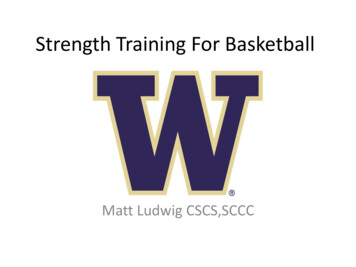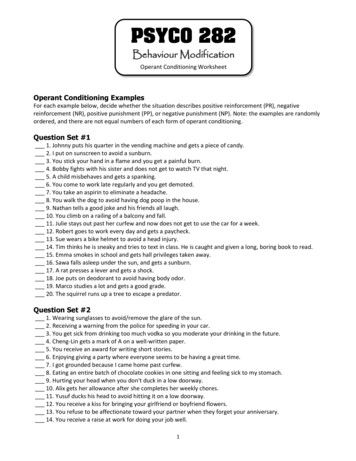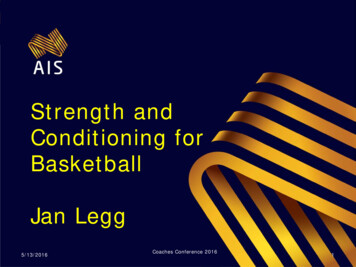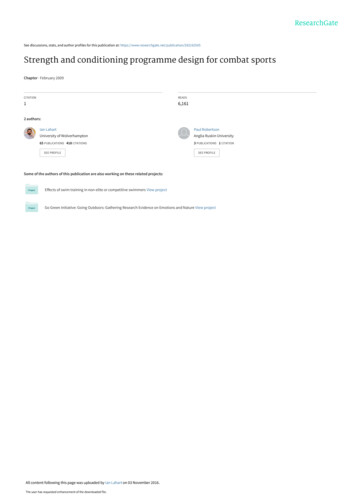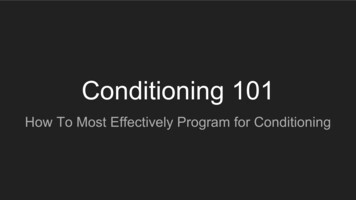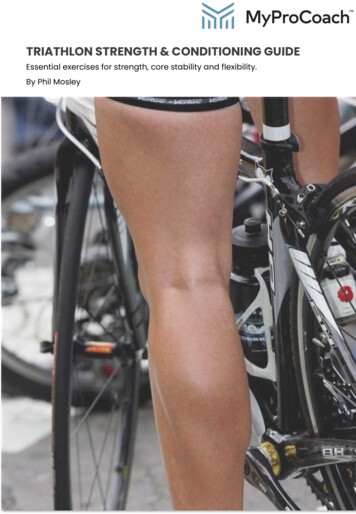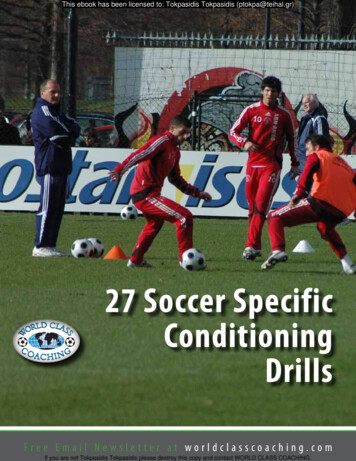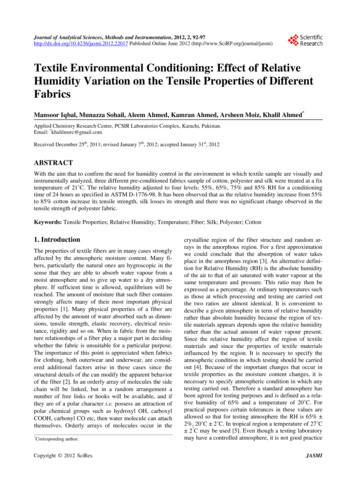
Transcription
STRENGTH &CONDITIONINGCounty Academy Athletes
STRENGTH & CONDITIONINGEngland Netball’s goal is to become and remain, the mostconsistently successful netball nation in the world. Encompassedwithin this is England Netball’s vision to become the best physicallyprepared netballing nation.What is Strength & Conditioning?It is important to recognise that it is your responsibility to take your Strength & Conditioningwork seriously at an early stage of your netball career. You need to learn to become abetter athlete as well as a netball player.A well rounded Strength & Conditioning programme aims to develop the physical capabilitieswithin an athlete so that they can continually train at a level that will allow netball athletesexisting in and entering the Performance Pathway to achieve the physical and technical skillsrequired to play senior level netball for England.THE STRENGTH & CONDITIONING PERFORMANCE PLANSenior AthletesSpeedPowerStrengthInjury PreventionStrength & Conditioning in netballfocuses on 4 key areas. This diagramrepresents the shift in importance ofthese 4 components as you movethrough the Performance Pathway.All of these components are importantfor your development as an athlete but atthe moment, the majority of your workshould be focussed on injury prevention.Satellite & CountyOur aim is to develop an athlete that is resilient to injury and has the physical qualitiesrequired for high performance netball. You can read about the type of training requiredfor this in more detail in the following sections.
WHAT DOES S&CTRAINING DO FOR ME?INJURY PREVENTIONKeeping you on the court is the primary concern of the Strength and Conditioning coach. Ifyou are injury free then you have greater time to spend with your Technical Coach and havegreater chances of making technical improvements on the court.It is important that you learn how to activate key muscle groups that stabilise your hips(glutes) and torso (spine and abdominals) so that you move efficiently, and are able to holdthe strongest positions body positions when on court.Injury prevention can be broken down into two main areas:1. ActivationThese exercises switch on the key muscles that are will help prevent injury and improve yourperformance on court.How often? These exercises should be done at least 4 times per week but ideally everyday.When? These exercises should be performed before you start your Netball sessions at thevery beginning of your warm up. If you are not playing on a given day find time to completethese exercises at home all you need is a floor! If you are playing other sports you shouldalso perform activation prior to starting- if you are preventing injury and improving yourperformance then you know it makes sense.Ask your Academy Coach to show you how to perform activation exercises safely andmost importantly effectively. Remember that excellence is a habit, not an act- so getpracticing!Figure 1. The Glute BidgeStartFinish
2. Landing SkillsYour ability to land safely and effectively in a variety of ways within 1.5 steps candramatically reduce your risk of injury and improve your on court performance. Landing wellwill protect areas at risk of injury such as the knee and the ankle as well as improve yourability to stay upright to see the players and court around you which will enable you releasethe ball faster to your team mates, make an interception and set the base for you to changedirection for the next play!How often? These exercises should be performed 4 times per week after you have finisheda set of activation exercises.When? These exercises should be performed prior to every netball session after you haveperformed your activation exercises. If you are going to be running, jumping, and landing ata high intensity during a netball session it is crucial that you have switched the right muscleson (activation) so that you can control your body in space and stop effectively in thestrongest and most efficient postures (landing skills).The quality of your execution of landing is very important and you must earn the rightto progress to the next level based on your ability. Your coach will put you through aseries of netball readiness tests. The results of these tests will dictate which landingskills programme you perform.There are 4 levels of the landing skills programme within the Academy structures.Each level becomes progressively more challenging as your athletic ability improves.The ‘hop and stop' test is an indicator of which level you should be completing.Figure 2. The Hop & Hold TestStart positionTransitionHopHold
STRENGTH & POWERStrength development is important as it increases your ability to produce force both statically(from standing still) and dynamically (on the move) as well as resisting forces placed uponthe body. Being able to produce a high amount of force increases your ability to run, jump,land and change direction and reduces risk of injury. The biggest goal of your strengthtraining at this stage is to increase the local muscular endurance of areas that are at risk ofinjury and keep you on the court.STRENGTH TRAINING TERMINOLOGY- WHAT DOES IT ALL MEAN?Rep: A rep is one unit of work for a given exercise. If your Strength & Conditioningprogramme lists an exercise as 12 reps you would do 12 units of work.Set: A set is a group of reps. If your Strength & Conditioning programme lists that you mustdo 3 sets of 12 reps then you would do 12 reps, rest the appropriate amount, and then repeatuntil you have done 3 groups of 12 reps.Rest: The rest period between sets is very important as it ensures that your muscles haveadequate recovery to complete high quality work during the next set. Strength training istaxing on the body and you should be able to do no more than 20 reps per set. If you can domore than 20 reps of a specific exercise with optimal technique then speak to your coachabout how you may progress that exercise.It is important that you are able to control your own bodyweight effectively and safely beforeloading yourself with equipment such as bands, med balls, dumbbells, and barbells. Youmust earn the right to progress exercises based on your physical and technicalcompetence.Power is the product of force and velocity (Power Force x Velocity) or the product ofstrength and speed (Power Strength x Speed). It is important at this stage of yourdevelopment to achieve a good level of Force/ Strength so that you are able to apply thishigh force quickly and so improving your power output! Performing exercises like jumps,hops, and leaps allow you to practice applying your force quickly and improve your poweroutput.How often? Strength training should be conducted twice per week.When? You have 2 main options for ordering when to do your strength training. These aredependent on how organised you are. If you’re smart about it you will be able to maximisethe benefit that that you are getting from your strength training.
STRENGTH & POWEROption 1: Prior to netball trainingYou should always be in a none-fatigued state prior to your strength & power trainingto get the greatest benefit from it. Strength training prior to netball training has thepotential to increase the activation of the muscles in the key areas of the body to thatwill enable to you to land, change direction, and jump more effectively.Option 2: Last training session of the day or on none netball daysEvery type of training “switches on” a pathway in the body to create an adaptation.The longer that pathway remains open and un-interrupted by another type of trainingsession potentially increases the benefit you gain from that session.ExamplesOption 1: Strength training at 5pm followed by netball training at 7pm means that thepathway for adaptation for strength training only remains fully open for 2 hours due to thefact that netball training sends a different message to the body.Option 2: Strength training at 7pm followed by no training until netball training at 7pm thefollowing day means that the pathway for adaptation remains fully open for 24 hours beforeanother message is sent to the bodyIf you’re organised you can be smart about maximising your adaptations! Don’t worryif this gets confusing- just make sure you’re strength training twice per week.Figure 3. Athlete demonstratingthe side squat exercise
STRENGTH & POWERPower Training Pointers (Effective Jumping and Landing Activities)Effective power training involves a high degree of skill, and powerful athletes are veryskilled at producing and absorbing force quickly. It is very important therefore thatyour technical execution of jumping and landing activities are of a high standard.Below are some examples of what to do and what not to do when completing jump(power) work:Jumping & Landing: What To Do Good take off position forjumping or single leg hopping/jumping:Weight through flat of feetHips and knees flexedHips, knees, and ankles all in astraight line when viewed from thefront. Good aerial position forjumping:Straight bodyHips, and knees extended(straight)Toes pulled up
Jumping & Landing: What not to doPiking- hips don’t fully extendand which doesn’t allow forfull power potential of thelower bodyToes pointed- too muchreliance on the lower leg(calf) which does notallow for full utilisation ofthe upper leg and hipmusclesHyperextension of the backcausing excessive stress on thespine partly due to pooractivation of the abdominals.Lack of contribution from thehipsTake-off and Landing: What Not To DoAthlete has moved too farforward onto the toes andwill therefore put morestress upon at risk areassuch as the ankle, knee,and spine.Medial (inward) trackingof the knees reduces thecontribution n of powerfulmuscles around the hipand knee. This positionwill also place excessstress on the knee andankle joints.Rotation of the hips/sittingto one side. Increasesthe pressure put throughone side of the body whenlanding and reducespower potential on takeoff.
SPEED & CONDITIONINGSpeed and change of direction speed (agility) sessions look to improve your on courtmovement skills. Speed sessions may involve improving your speed off the mark, yourability to decelerate, footwork patterns, or change direction to get free.It is important that quality of execution is your main aim during speed and change ofdirection speed sessions. The primary goal of this kind of training is to make you move moreefficiently to and improve how much force (strength) you can put into the ground which willreduce your risk of injury and allow you to outrun, and outlast your opponents.How often? Speed and change of direction speed training should be performed 1-2 timesper week.When? Speed sessions are best done on none netball session days or can be incorporatedinto the start of a netball specific movement session.Speed & change of direction technique pointersHere Pamela Cookey is demonstrating change of direction off the right foot. Thefollowing points are what you should focus on when completing speed and change ofdirection sessions:-Centre of mass (belly button area of the body) is placed far away from the base of support(supporting right leg-) by challenging this relationship (making these two points as far awayas possible) you will be able to decelerate, change direction, and accelerate more efficiently.-Head position- by turning the head and looking at where you want to go early will helporientate your hips in the direction you wish to travel. This will improve how you are able tochange direction in small spaces, and how much effective force you are able to put into theground.-Force production and posture- the athlete has worked hard to decelerate by placing alarge amount of force into the ground. Note the straight line between the right leg and torso.It requires a large amount of force and intent to hold these postures in speed and change of
SPEED & CONDITIONINGdirection speed scenarios. Your main focus in speed sessions should therefore beeffective postures and intent to put force into the ground!CONDITIONINGNetball is primarily about short bursts of multi directional and aerial movements. A team orindividual that possesses the ability to repeat these movements through the course of amatch or tournament will hold a physical advantage over their opponent.Conditioning sessions look to develop your cardiovascular system (heart & lungs) and themuscular system to a level where you can produce energy at a high rate repeatedly (repeatsprints and change of direction) or sustain a lower rate of energy production for an extendedperiod (prevent decline in performance as a game continues) depending on the work: restratio used.Work-rest ratios of 1:1 to 1:2 are used to promote adaptations that sustain a steady rate ofenergy production. This improves your ability to keep going at a relatively high work rate.The content of these sessions may include having to cover a set distance in a set timerepeatedly.Longer work-rest ratios are required to get the most out of sessions that focus on a high rateof energy production. This improves your ability to repeatedly sprint and change direction.It is important to include sessions geared towards rate of energy production (speed) andsustaining energy production (endurance) as part of your program. A variety of methodsshould be used including on court interval work, circuits, off-feet conditioning such as rowing,cycling and pool work.How often? Conditioning should be performed 2-3 times per week at this stage of yourdevelopment.When? Ideally conditioning work is performed on days where you’re not completing anystrength work as these two types of training have the opposite effect of one another.Conditioning can also be classified as another sport at this stage of your development.Your conditioning program should be prescribed based on your current ability. Afteryou have undergone the bleep/ multi stage fitness test with your coach will select themost appropriate conditioning sessions for you. This will be re-evaluated each timeyou perform the bleep test.
STRENGTH & CONDITIONING PROGRAMME FOR SATELLITE AND COUNTY ACADEMY ATHLETESAims of Strength and Conditioning programme1. Reduce injury risk2. Prepare players for frequent high-intensity Netball training3. Provide a positive experience of, and educate players on, Strength and Conditioning in netballThis Strength and Conditioning Programme is made up of three different types of session; Landing Skills & Warm Ups,Strength & Power and Conditioning sessions. You will need to incorporate a mixture of these sessions into your weeklytimetable. Following on from your Netball Readiness Assessment with your coach, you will be told which level of theConditioning and Landing Skills sessions to complete.The Strength and Conditioning session in My Game Plan will help you to understand the terminology used and provide anexplanation of why completing these exercises is so important.If you are unsure of any exercises please refer to the picture explanations or ask your coach for help.Netball Readiness AssessmentThis assessment gives an idea of your physical readiness to partake in high-level netball (see additional document forassessment protocols).Assessment Tools:-Overhead and single leg squatsHop and Stop testBleep test
FMS ScoreLanding SkillsProgrammeBleep Test LevelHop & Stop ScoreConditioningProgrammeYour performance on the below assessments dictates which programmes you will follow on the subsequent pages (please see table below). 7 11 85% 18 22 85-89% 29 33 90-94% 310 43 95% 4
LoadMax RepsRestTempoRepsSetsLoadWeek 4Max RepsRestTempoRepsSetsLoadWeek 3Max RepsRestRepsSetsLoadWeek 2Max RepsRestTempoRepsPerform the activation exercisesfollowed by either Level 1, 2 or 3landing skills programme. Perform thissession 4 times a week includingusing it as a warm-up before a courtsession.Week 1Tempo& WARM-SetsLANDINGUPSActivationBent knee lift (each leg) SUPINE18-bw18-bw28-bw28-bwClams (each leg) SIDE18-bw18-bw28-bw28-bwStraight leg lift (eachleg) SUPINE18-bw18-bw28-bw28-bwStraight leg lift (each leg) SIDE18-bw18-bw28-bw28-bwHip extension (each leg) PRONE18-bw18-bw28-bw28-bwGlute bridge SUPINE18-bw18-bw28-bw28-bwElbow raise with scap squeeze PRONE18-bw18-bw28-bw28-bwLevel 1 Landing SkillsSL Balance (each leg)130s130s145s145sArabesque (each leg)18182828Jump squat251102611260sbwbw60sbwbw
Leap & hold (each leg)2560sbw110bw2660sbw112bwHop & hold into skater squat (each leg)2560sbw110bw2660sbw112bwBroad Jump (max distance)110bw110bw21060sbw21060sbwLateral hop with 90 deg hold on last(each leg)110bw110bw21060sbw21060sbw60sbwLevel 2 Landing SkillsSL Balance (each leg)160s160s230s230sArabesque (each leg)2828210210Jump squat3560sbw210bw3660sbw36Leap & hold (each leg)2560sbw110bw2660sbw112bwHop & hold (each leg)2560sbw110bw2660sbw112bwLateral jump to single leg land110bw110bw21060sbw21060sbwLateral step off bench into Hop & Stick(each leg)2560sbw110bw21060sbw21060sbwLateral hop x3 & stick (each leg)2560sbw110bw21060sbw21060sbw160s230s60sLevel 3 Landing SkillsSL Balance (each leg) - eyes closed230s160s
SL Squat (each leg)212212212Jump squat3560sbw210bw3660sLeap & hold (each leg)2560sbw110bw26Hop & hold (each leg)2560sbw110bw2Jump squat 90 degrees rotation110bw110bwSingle Leg Drop to Leap out (each leg)2560sbw110Forward Backward Hop 90 degrees(each bw60sbwLevel 4 Landing SkillsSL Balance (each leg) throwing task230s160s160s230sSL Squat (each leg)212212212212Jump squat3560sbw210bw3660sbw36Froward Leap & diagonal stick (eachleg)2560sbw110bw2660sbw112bw1 Back 2 Forward Hop & hold (each leg)2560sbw110bw2660sbw112bwJump squat 180 - 360 degrees rotation110bw110bw21060sbw21060sbwLateral leap & hold (each bw21060sbw180 deg jump to Single Leg Landing60s
warm-up activation & landing skillstempo e.g. 1 lift, 2 hold, 4 lowerrest seconds between setsVideo Link to Landing Skills
LoadMax RepsRestTempoRepsSetsLoadWeek 7/8Max RepsRestTempoSetsLoadRepsWeek 5/6Max RepsRestTempoRepsSetsLoadWeek 3/4Max RepsRestTempoSetsRepsWeek 1/2County AcademyStrength & PowerSessions (3 months)1. ActivationBent knee lift (each leg) SUPINEClams (each leg) 288124124-bwbwSL Balance230sStraight leg lift (eachleg) SUPINE18124-bw18124-bw28124-bw28124-bwStraight leg lift (each leg) SIDEElbow raise with scap bw18124-bw28124-bw28124-bwLocal Muscular EnduranceSL Calf RaiseSL Supported Squat2215156060331515606044151560604420206060Side squat21560315604156042060Partner resisted Hamstring Curl2156031560415604206021560315604156042060Duck Walks2660315604156042060Walking Lunge with A-Hold215es60315604156042060Arabesque Shoulder Shapeswarm-up activation & landing skillstempo e.g. 1 lift, 2 hold, 4 lowerrest seconds between setsbw bodyweightVideo link to Activation DrillsVideo link to Local Muscular Endurance
COUNTY ACADEMY CONDITIONING SESSIONSThese sessions will improve your general conditioning and enable to recover more quickly between high intensity efforts.Your choice: preferably on feet (sports hall, track, field, pavement) but if injured adapt to gym equipment to reduce impact or be totally off-feete.g. treadmill, cross-trainer, bike, rower.Perform two conditioning sessions (minimum) in a week in addition to your netball sessions - rotate so you include all of them - do NOT stickwith the same one throughout.Always warm up first (activation & landing skills & a few progressive sprints)Finish with a cool-down & stretchLevel 2: Sprints 1:4 (Track/Field/Netball Court) x 1/weekWeeks1 to 420m (3-4s, 16s recovery)1240m (6-8s, 32s recovery)1060m (8.5-12s, 48s recovery)680m (11.5-16s, 64s recovery)4100m (14-20s, 80s recovery)3Total metres16205 to 810864315009 to 1297532120013 to 16864321080(Approximate 1/3 netball court 10 metres - this will add a little to the time taken due to the turns involved).As reps and total distance go down across the weeks, increase speed.Level 3: Doom Runs(Netball Court) x1/week1234RRecTotalReRecoRe RecoTotalTotal DistanceepReps covTotal 14405120s18006120s216072520ss1 rep approx 180m: SPRINT from goal line to top of circle & back, then to 1st transverse line & back, centre circle & back, 2nd transverse line & back, top of other circle & back, toend goal line & WALK back ensure full recovery time is taken (120s between reps & 240s between sets)2 sets 240s betweensetsReps
Level 1: Intervals x 1/week4&34mins @ 90% followedby 3mins @ 70%Reps4Level 1: Speed Intervalsx 1/weekweeks 1 - 4weeks 4 - 8weeks 9 - 1230 / 30RepsSetsRecoveryRepsSetsRecovery30s max speed 100%followed by 30s @ 50%6mins2120s6mins3120sLevel 2: Shuttles x1/weekweeks 1 - 4weeks 4 - 8RepSets RecoveryRepsSetsRecoverys3 different distances in one session: at each work for 30secs at max speed with 30s walk recovery15m (1/2 court)6120s8120s10m (1/3 court)6120s8120s5m (transverse line6120s8120sto centre circle)30 / 30Reps6minsSetsRecovery4120sweeks 13 - 16Reps6minsSetsRecovery5120sweeks 9 - 12weeks 13 - 0-120s120s10-120s10-120s
Level 4: PositionalEndurance x 1/wkDistance1/3rdsReps xSetsGS / GK200m206x312GA / WA / WD /GD300m306x312C400m406x310.6Cool-down 1: 11 4 5run court lengths at11secs per lengthstretchWork:Rest Ratioe.g.40secs to cover distance: 80secs rest60secs to cover distance: 120secs rest80secs to cover distance: 134secs restCool-down 2: 5 4 35minsRun 5 court lengths5minsJog 4 court lengthsWalk 3 court lengths and perform a different stretch at each transverse line.Recovery betweensetsTotal distance360secs3600m360secs5400m360secs7200m
SATELLITE AND COUNTY ACADEMY STRENGTH AND CONDITIONING GUIDELINESNetball Readiness Assessment (NRA)Netball is a physically demanding sport at every level of the game. To participate in high-level Netball you will need to be able totolerate a high impact, high training volume programme without getting injured. The NRA assesses your ability to deal with these highloads.Landing Skills/Warm-UpLanding skills are an integral part of any Netball session. Landing skills reduce your chance of injury as well as improve yourmovement on-court. Before every session you should complete at least 10 minutes of landing skills as part of a 20 minute warm-up.You stretch and roll your tight areas, complete the activation and the landing skills programme dictated by your NRA score. Once youhave completed both of these your coach will lead you through some Netball specific warm-up activities.PrehabPrehab is another way to reduce the chance of injury by working on the areas we know are prone to injury when playing Netball.Some of these exercises can be used as part of your warm-up. In general you should be completing prehab sessions on most days.Local Muscular EnduranceThese sessions prepare specific muscle for the demands of Netball and for more demanding resistance training later on.ConditioningAs a Netballer you will get your aerobic fitness from Netball training. Netball is a high-intensity repeated effort sport. As such youneed perform explosive movements with limited recovery. The conditioning programme will provide you with the general physiologicaladaptations to do this.
NETBALL READINESS ASSESSMENT - FMS AND HOP & STOP TEST TRAININGJuly 2013The purpose of the process outlined within this document is to improve the level of physical preparedness of Netball players enteringPerformance Programmes.Equipment required: 2 x Yellow pages (or similar)/2 x packet A4 paperTape MeasureCamera/Video CameraProtocols:Modified FMS (Testing to be performed barefoot)Overhead squat Participants are required to stand upright with arms straight above their head at 45 Participants are instructed to squat as low as possible keeping their arms overhead and heels on the ground.If participant is unable to perform the movement adequately, a 5cm block is placed under the heels and the movement is performedagain.The lowest score recordedSingle Leg Squat Participants are required to stand on one leg with arms straight out in front of them parallel to the floor.Participants are instructed to squat as low as possible on their standing leg with arms at parallel and heel on the groundIf participant is unable to perform the movement adequately, a 5cm block is placed under the heel and the movement is performed again.
Hop & Stop Test Ascertain the height of the participant either using a tape measure or stadiometerStandard start position - Participants should be positioned with their toe at the base of the measuring tape with hand on hips and theopposite leg in the air at a hip angle of 90 (top of thigh parallel with floor)If three good hops/leaps are not achieved within 5 attempts a 90s rest should be takenHop for distance (Force Production) Landing during this part of the test is not the priority, once the leg being tested has contacted the floor the other leg can be placed onthe floor to prevent fallingOne practice hop is permitted. After the practice hop is completed three maximal hops are performed.Measurement is taken from the toe. Carry out the same procedure on the other leg.Hands must stay on hips and there must be minimal back swing from the non-standing leg.If these criteria are not met the attempt is void.Maximal Controlled Leap (Force Absorption) During this part of the test landing is the critical factor.Participants have one second to come to a complete stop after landing. If this criteria is not met the attempt is voidParticipants are instructed to leap onto the opposite foot.Ensure participants do not to simply extend their lead leg, but to maintain the flexed knee/hip position throughout the take-off phase,extending their lead leg only for landing.Hands must stay on hips and there must be minimal back swing from the non-standing leg
Modified FMS Scoring CriteriaExerciseOhSquat3Upper Torso parallel withtibiaFemur below parallelKnees aligned over feetArms in-line/behind ears2As 3 but with raisedheel1Upper torso and tibianot alignedKnees not aligned withfeetLumbar flexion noted0Any pain associatedwith test movementSLSquatUpper Torso parallel withtibiaFemur below parallelKnees aligned over feetArms parallel with thefloorAs 3 but with raisedheelUpper torso and tibianot alignedKnees not aligned withfeetLumbar flexion notedAny pain associatedwith test movement
England Excel: Entry Level Screening Raw Data SheetEnglandnetballL HopNameHeight (CM)Raw Score Final Score Total FMSTestOverhead Squat12R Hop312L Leap312R Leap3123LSingle Leg SquatROverhead SquatSingle Leg SquatLROverhead SquatSingle Leg SquatLROverhead SquatSingle Leg SquatLROverhead SquatSingle Leg SquatLROverhead SquatSingle Leg SquatLROverhead SquatSingle Leg SquatLROverhead SquatLSingle Leg Squat.Overhead SquatSingle Leg SquatLR*For single legsquat the lowest raw score is given as the final scorer0--gland\E tball
STRENGTH & POWER Option 1: Prior to netball training You should always be in a none-fatigued state prior to your strength
